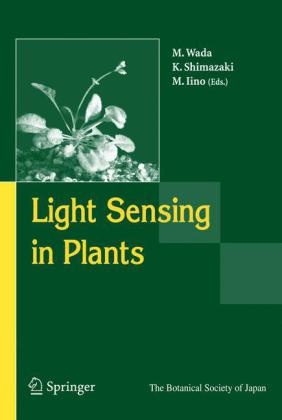Read more
Plants utilize light not only for photosynthesis but also as environmental signals. They are capable of perceiving wavelength, intensity, direction, duration, and other attributes of light to perform appropriate physiological and developmental changes. This volume presents overviews of and the latest findings in many of the interconnected aspects of plant photomorphogenesis, including photoreceptors (phytochromes, cryptochromes, and phototropins), signal transduction, photoperiodism, and circadian rhythms, in 42 chapters. Also included, is a prologue by Prof. Masaki Furuya that gives an overview of the historical background. With contributions from preeminent researchers in specific subjects from around the world, this book will be a valuable source for a range of scientists from undergraduate to professional levels.
List of contents
Prologue.- History and Insights.- Phytochrome.- Phytochrome Overview.- Evolutionary Selection of Phytochrome Chromophores.- Tertiary and Quaternary Structures of Phytochrome A.- Interactions of the Arabidopsis Type II Phytochromes.- A Structure-Function Model Based on Inter-Domain Crosstalks in Phytochromes.- Functions of Different Domains of Phytochrome.- Light Regulation of Intracellular Localization of Phytochrome B.- Photoregulation of Cytoplasmic Motility.- Polymorphism of Phytochrome A and Its Functional Implications.- Phytochromes and Functions: Studies Using Gene Targeting in Physcomitrella.- Distinct Functions of Phytochromes on the Photomorphogenesis in Rice.- Cryptochrome.- Cryptochrome Overview.- Early Events Triggered by Light Activation of the Arabidopsis CRY1 Blue-Light Photoreceptor.- Phototropin.- Phototropin Overview.- Proton Transfer Reactions in LOV-Domain Photochemistry.- Vibrational Spectroscopy Explores the Photoreaction of LOV Domains.- LOV Domain-Containing Proteins in Arabidopsis.- Phototropin Phosphorylation.- NPH3 and RPT2: Signal Transducers in Phototropin Signaling Pathways.- Molecular Mechanism of Blue Light Response in Stomatal Guard Cells.- Chloroplast Photorelocation Movement.- Other Photoreceptors.- Structural Dynamics of the Signal Termination Process in Rhodopsin.- Participation of Internal Water Molecules and Clusters in the Unidirectional Light-Induced Proton Transfer in Bacteriorhodopsin.- Phototaxis Photoreceptor in Euglena gracilis.- A Flavin Mononucleotide-Binding Aquaporin in the Plant Plasma Membrane: A Candidate for Photoreceptor?.- Green Light Effects on Plant Growth and Development.- Photoreceptors in Avian Magnetoreception.- Signal Transduction.- Light Control of Plant Development: A Role of theUbiquitin/Proteasome-Mediated Proteolysis.- Phytochrome and COP1 Regulates Abundance of Phytochrome Interacting Factor 3.- Roles Played by Auxin in Phototropism and Photomorphogenesis.- The Effect of Light and Gravity on Hypocotyl Growth Orientation.- Convergence of Phytochrome and Cryptochrome Signalling.- Downstream Integrators of Red, Far-Red, and Blue Light Signaling for Photomorphogenesis.- Signal Transduction Pathways Regulating Chromatic Adaptation.- Components of Light-Induced Signal Transduction in Cyanobacteria.- Light Signal Transduction Coupled with Reactive Oxygen Species in Neurospora crassa.- Photoperiodism and Circadian Rhythm.- Light Regulation of Flowering Time in Arabidopsis.- Comparative Molecular Biology in Photoperiodic Flowering Between the Short-Day Plant Rice and the Long-Day Plant Arabidopsis.- The Photoperiodic Control of Flowering in Rice, a Short-Day Plant.- ZEITLUPE and the Control of Circadian Timing.- Epilogue.- Epilogue: Eighteen Years of Progress in Photomorphogenesis.
Summary
Plants utilize light not only for photosynthesis but also as environmental signals. They are capable of perceiving wavelength, intensity, direction, duration, and other attributes of light to perform appropriate physiological and developmental changes. This volume presents overviews of and the latest findings in many of the interconnected aspects of plant photomorphogenesis, including photoreceptors (phytochromes, cryptochromes, and phototropins), signal transduction, photoperiodism, and circadian rhythms, in 42 chapters. Also included, is a prologue by Prof. Masaki Furuya that gives an overview of the historical background. With contributions from preeminent researchers in specific subjects from around the world, this book will be a valuable source for a range of scientists from undergraduate to professional levels.

